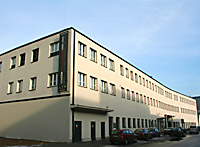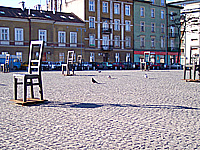The Krakow Ghetto
German authorities created the Jewish ghetto in
Krakow under the Nazi occupation on March 3, 1941
as a compulsory dwelling place for the city's Jews. On the
order of Dr Otto Wachter, the district gubernator, the
central part of
Podgorze borough was closed off and all its
gentile residents expelled to make room for some 17,000 Jews
who were allowed to remained in the then capital of a German
dependency made of the rump of Poland and called General-Gouvernement.
The rest of the 65,000-strong prewar Jewish population of
Krakow had been relocated earlier to Poland's lesser cities,
towns, and villages.
Geography of the Krakow ghetto.
The Nazi-conceived Jewish ghetto in Krakow was situated in
Podgorze area on the right bank of Wisla river opposite
Kazimierz district and its historical
Jewish Quarter. Originally the ghetto took up the
area of roughly twenty hectares that stretched from Plac
Zgody square (now Plac Bohaterow Getta) to Rekawka street
and between Lwowska street and Wegierska street. It was
strategically situated next to Zablocie industrial district
with many plants, including now famous 'Schindler's
factory', that could utilize the cheap forced
labor of the ghetto inhabitants. Also the
Plaszow concentration camp was near by. And the
adjoining Zablocie train station facilitated future
deportations.

'Schindler's Factory', i.e. Emalia plant run by Oskar
Schindler from 1939 to 1944, has been recently turned into a
museum.
The Krakow ghetto consisted of fifteen different streets or
parts of them and contained 320 buildings comprising some
3,200 rooms.
The ghetto in Krakow was sealed off, with a high wall
erected round it, and only four gates guarded by German
solders linked it with the outside world. The main gate was
situated on the ghetto's western edge, at Limanowskiego
street near Rynek Podgorski square, two other at Lwowska
street (east) and at Zgoda square (south), while another
entrance at Limanowskiego street was meant solely for German
military vehicles.
Living conditions in the ghetto in Krakow.
The German authorities rigorously rationed
food in Poland and they decreed that the ghetto
Jews might survive on as little as one hundred grams of
bread per day and two hundred grams of sugar or fat per
month. No wonder both starvation and black market were
rampant. Potatoes smuggled from the Polish peasants became
the everyday sustenance for families which could afford
them.
The Krakow ghetto was overcrowded as its Nazi overseers
decided that at least four Jewish families should share
every flat.
Most apartment houses and other buildings were in bad
repair.
The Germans made all Polish Jews to wear armbands with the
Star of David. Soon the access of ghetto inhabitants to the
rest of Krakow was restricted to an absolute minimum. Even
windows looking outwards were bricked up.
The rationale for letting Jews stay in Krakow was their
contribution to the German war effort so the ghetto
residents had to work in German factories. The workers were
issued identity cards that provided some protection from
persecution, for the time being.
Everyday matters of the ghetto in Krakow were managed by so
called 'Jewish Council', Judenrat. It consisted of Jews
appointed by the local commander of the frightful SS police.
The Judenrat was responsible for carrying out German
instructions duly, exactly, and without delay. Its orders
were enforced by Jewish policemen.
Destruction of the Krakow ghetto.
Over two years of its existence several thousand residents
of the Jewish ghetto in Krakow were either killed or died of
hunger. Then the Nazis emptied Krakow's ghetto
systematically in three waves.
On May 30, 1942 the ghetto dwellers without identity cards
were rounded up on Plac Zgody square (today's Plac Bohaterow
Getta square) and roughly 4,000 of them left for the Belzec
death camp to perish there. Since the Judenrat didn't meet
the German-set quota of deportees, SS storm troopers killed
some 600 Jews on the streets of the ghetto on June 4. By the
end of June the Nazis formally decreased the area of the
Krakow ghetto.
On October 28, 1942 such 'excessive' ghetto residents as the
sick, the old, the handicapped, and little children became
the target. Some 600 were murdered outright and about 4,500
shipped by train to Belzec concentration camp.
From November 1942 on the Nazis were transferring Jewish
laborers from the ghetto to the nearby Plaszow camp. In
December 1942, the German authorities carved the Krakow
ghetto up into zone A for usable work force and zone B meant
for the rest of Jews.
On March 13, 1943 so-called Ghetto A was closed down and all
remaining Jewish workers imprisoned in the Plaszow
concentration camp. Next day the SS troops emptied Ghetto B
killing its Jewish inhabitants in their homes and in the
streets. Several hundred Jews were trucked to the notorious
Auschwitz death camp in Oswiecim.
The ransacking of the Krakow ghetto continued till December
1943.
Steven Spielberg's famous film, Schindler's List, shows the
tragedy of the Jewish ghetto in Krakow.
Krakow's relics of the Jewish ghetto.
Little has remained of the Krakow wartime ghetto demolished
by the Nazis in 1943. There are fragments of its wall at 25
Lwowska street and 62 Limanowskiego street. Also many
apartment houses survived but they don't differ from other
properties in Krakow
of the same age.
Pharmacy Under an Eagle /Apteka Pod Orlem/ at
18 Plac Bohaterow Getta square, former Plac Zgody square,
was run by a Pole during the World War II and provided a
cover for the Polish resistance that tried to help Jews in
ghetto. The former drugstore has been turned into a tiny
museum of the holocaust in Krakow, a branch of
the city's Museum of History, open daily from 9:30 a.m. to 5
p.m. except on Mondays it's 10 a.m. to 2 p.m.
The entire Plac Bohaterow Getta square, Ghetto Heroes Square
in English, has been turned into a monument commemorating
the Jewish ghetto and the Krakow Jews.

Memorial to victims
of the Krakow ghetto in the form of oversized bronze chairs on
the Plac Bohaterow Getta square.
|




